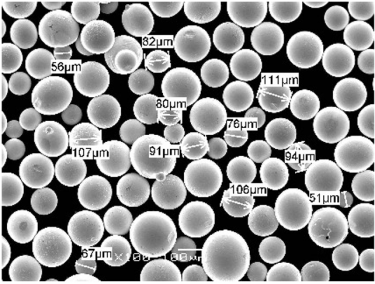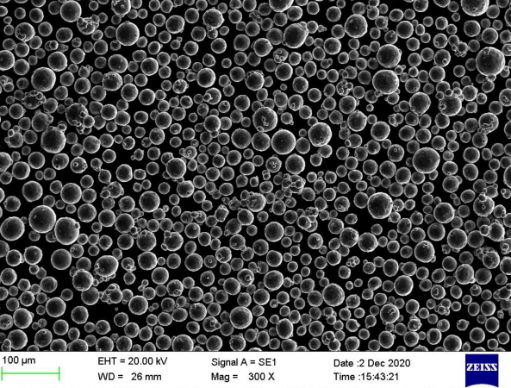Willkommen zu unserem umfassenden Leitfaden zu Elektrode Induktionsschmelzen Inertgas (EIMIG), einer hochentwickelten Technik, die bei der Herstellung hochwertiger Metallpulver eingesetzt wird. Egal, ob Sie Materialingenieur, Forscher oder einfach nur neugierig auf fortschrittliche metallurgische Verfahren sind, dieser Artikel soll Ihnen ein detailliertes Verständnis von EIMIG vermitteln. Wir werden uns mit seiner Mechanik befassen, spezifische Metallpulvermodelle untersuchen und seine verschiedenen Anwendungen hervorheben. Also, fangen wir an!
Überblick über Elektroden-Induktionsschmelzen Inertgas
Elektroden-Induktionsschmelzen Inertgas (EIMIG) ist ein hochmodernes metallurgisches Verfahren, bei dem Metalle unter Verwendung eines Lichtbogens geschmolzen werden, der zwischen Elektroden in einer Inertgasumgebung erzeugt wird. Diese Methode ist besonders vorteilhaft für die Herstellung von hochreinen Metallpulvern, die in Branchen von der Luft- und Raumfahrt bis zur Biomedizintechnik unerlässlich sind.
Was macht EIMIG so besonders?
EIMIG zeichnet sich durch seine Fähigkeit aus, Metallpulver mit überlegener Reinheit und kontrollierten Partikelgrößen herzustellen. Durch die Verwendung einer Inertgasatmosphäre, typischerweise Argon oder Helium, werden Oxidation und Kontamination minimiert, wodurch die Herstellung hochwertiger Metallpulver gewährleistet wird. Das Verfahren ist auch sehr vielseitig und ermöglicht das Schmelzen einer Vielzahl von Metallen und Legierungen.
Hauptkomponenten von EIMIG
- Elektroden: Diese werden in der Regel aus Graphit oder Wolfram hergestellt und erzeugen den für das Schmelzen erforderlichen Lichtbogen.
- Inertgasumgebung: Argon oder Helium werden üblicherweise verwendet, um Oxidation zu verhindern.
- Induktionsheizsystem: Liefert die notwendige Energie, um den Schmelzprozess aufrechtzuerhalten.
- Schmelztiegel: Hält das Metall, während es schmilzt und sich zu Pulver formt, fest.

Arten von Metallpulvern, die durch EIMIG hergestellt werden
EIMIG kann eine Vielzahl von Metallpulvern herstellen, die jeweils einzigartige Eigenschaften für verschiedene Anwendungen aufweisen. Hier sind zehn spezifische Modelle:
1. Titan-Legierung (Ti-6Al-4V)
Zusammensetzung: Titan, Aluminium, Vanadium
Eigenschaften: Hohes Verhältnis von Festigkeit zu Gewicht, ausgezeichnete Korrosionsbeständigkeit
Anwendungen: Luft- und Raumfahrtkomponenten, medizinische Implantate
2. Nickel-Superlegierung (Inconel 718)
Zusammensetzung: Nickel, Chrom, Eisen, Niob
Eigenschaften: Hochtemperaturbeständigkeit, ausgezeichnete mechanische Eigenschaften
Anwendungen: Turbinenschaufeln, Strahltriebwerke
3. Edelstahl (316L)
Zusammensetzung: Eisen, Chrom, Nickel, Molybdän
Eigenschaften: Hohe Korrosionsbeständigkeit, gute Formbarkeit
Anwendungen: Biomedizinische Geräte, Geräte zur Lebensmittelverarbeitung
4. Kobalt-Chrom-Legierung (Co-Cr-Mo)
Zusammensetzung: Kobalt, Chrom, Molybdän
Eigenschaften: Hohe Verschleißfestigkeit, Biokompatibilität
Anwendungen: Zahnimplantate, orthopädische Implantate
5. Aluminiumlegierung (AlSi10Mg)
Zusammensetzung: Aluminium, Silizium, Magnesium
Eigenschaften: Geringes Gewicht, gute Wärmeleitfähigkeit
Anwendungen: Automobilteile, Luft- und Raumfahrtstrukturen
6. Kupferlegierung (CuNi2SiCr)
Zusammensetzung: Kupfer, Nickel, Silizium, Chrom
Eigenschaften: Hohe elektrische Leitfähigkeit, gute mechanische Festigkeit
Anwendungen: Elektrische Steckverbinder, Wärmetauscher
7. Werkzeugstahl (H13)
Zusammensetzung: Eisen, Chrom, Molybdän, Vanadium
Eigenschaften: Hohe Zähigkeit, ausgezeichnete Hitzebeständigkeit
Anwendungen: Formen für Druckguss, Extrusionswerkzeuge
8. Martensitaushärtender Stahl (18Ni300)
Zusammensetzung: Eisen, Nickel, Kobalt, Molybdän
Eigenschaften: Hohe Festigkeit, gute Zähigkeit
Anwendungen: Luft- und Raumfahrtkomponenten, Werkzeuge
9. Wolframkarbid (WC-Co)
Zusammensetzung: Wolfram, Kobalt
Eigenschaften: Extrem hart, hohe Verschleißfestigkeit
Anwendungen: Schneidwerkzeuge, Bergbauausrüstung
10. Zirkoniumlegierung (Zr702)
Zusammensetzung: Zirkonium, Hafnium, Eisen
Eigenschaften: Ausgezeichnete Korrosionsbeständigkeit, gute mechanische Eigenschaften
Anwendungen: Kernreaktoren, Geräte zur chemischen Verarbeitung
Merkmale von Elektrode Induktionsschmelzen Inertgas
EIMIG ist bekannt für mehrere Schlüsselfaktoren, die es zu einer attraktiven Option für die Herstellung von Metallpulvern machen.
Reinheit
Die Inertgasumgebung reduziert die Kontamination erheblich, was zu Metallpul
Kontrolle der Partikelgröße
EIMIG ermöglicht eine präzise Steuerung der Partikelgrößenverteilung, was für Anwendungen, die spezifische Pulvereigenschaften erfordern, von entscheidender Bedeutung ist.
Vielseitigkeit
Das Verfahren ist an eine Vielzahl von Metallen und Legierungen anpassbar, wodurch es für verschiedene industrielle Anwendungen geeignet ist.
Efficiency
EIMIG ist ein energieeffizientes Verfahren, das in der Lage ist, hohe Ausbeuten an Metallpulver mit minimalem Abfall zu erzeugen.
Anwendungen des Elektroden-Induktionsschmelzens unter Schutzgas
EIMIG-produzierte Metallpulver finden aufgrund ihrer überlegenen Eigenschaften in verschiedenen High-Tech-Industrien Verwendung.
Luft- und Raumfahrtindustrie
Hochfeste, leichte Legierungen wie Ti-6Al-4V sind für Flugzeugkomponenten von entscheidender Bedeutung, bei denen Leistung und Zuverlässigkeit von größter Bedeutung sind.
Biomedizinische Technik
Biokompatible Materialien wie Co-Cr-Mo werden in medizinischen Implantaten und Geräten verwendet, um die Sicherheit und Wirksamkeit für die Patienten zu gewährleisten.
Automobilsektor
Aluminiumlegierungen wie AlSi10Mg werden in Automobilteilen verwendet, um das Gewicht zu reduzieren und die Kraftstoffeffizienz zu verbessern.
Elektronik
Kupferlegierungen mit hoher elektrischer Leitfähigkeit sind für Steckverbinder und andere elektronische Bauteile unerlässlich.
Werkzeugbau und Fertigung
Werkzeugstähle und Wolframkarbidpulver werden zur Herstellung von langlebigen Formen und Schneidwerkzeugen für verschiedene Fertigungsprozesse verwendet.






Detaillierte Spezifikationen von EIMIG-Metallpulvern
Eigenschaften und Merkmale
| Metall-Pulver | Dichte (g/cm³) | Schmelzpunkt (°C) | Härte (HV) | Zugfestigkeit (MPa) | Dehnung (%) |
|---|---|---|---|---|---|
| ti-6al-4v | 4.43 | 1660 | 349 | 895 | 10 |
| Inconel 718 | 8.19 | 1350 | 330 | 1240 | 12 |
| 316L-Edelstahl | 7.99 | 1375 | 217 | 620 | 40 |
| Co-Cr-Mo | 8.29 | 1330 | 450 | 900 | 8 |
| AlSi10Mg | 2.68 | 570 | 85 | 310 | 7 |
| CuNi2SiCr | 8.78 | 1083 | 100 | 450 | 20 |
| H13 Werkzeugstahl | 7.80 | 1427 | 750 | 1450 | 12 |
| 18Ni300 Maraging-Stahl | 8.00 | 1413 | 340 | 2000 | 10 |
| WC-Co | 15.60 | 2870 | 1600 | – | – |
| Zr702 | 6.50 | 1855 | 250 | 550 | 30 |
Anwendungen und Einsatzmöglichkeiten
| Metall-Pulver | Primäre Anwendungen | Zusätzliche Verwendungen |
|---|---|---|
| ti-6al-4v | Komponenten für die Luft- und Raumfahrt, medizinische Implantate | Sportartikel, Marineanwendungen |
| Inconel 718 | Turbinenschaufeln, Strahltriebwerke | Kernreaktoren, Raumfahrzeuge |
| 316L-Edelstahl | Biomedizinische Geräte, Lebensmittelverarbeitung | Chemische Verarbeitung, Marineanwendungen |
| Co-Cr-Mo | Zahnimplantate, orthopädische Implantate | Uhrenkomponenten, Industrielager |
| AlSi10Mg | Automobilteile, Luft- und Raumfahrtstrukturen | Unterhaltungselektronik, Fahrräder |
| CuNi2SiCr | Elektrische Steckverbinder, Wärmetauscher | Marineanwendungen, Münzprägung |
| H13 Werkzeugstahl | Formen für Druckguss, Extrusionswerkzeuge | Spritzgussformen, Gesenkschmieden |
| 18Ni300 Maraging-Stahl | Komponenten für die Luft- und Raumfahrt, Werkzeugbau | Hochleistungszahnräder, Wellen |
| WC-Co | Schneidwerkzeuge, Bergbauausrüstung | Verschleißfeste Teile, Bohrwerkzeuge |
| Zr702 | Kernreaktoren, chemische Verarbeitung | Medizinische Geräte, Komponenten für die Luft- und Raumfahrt |
Spezifikationen, Größen, Güteklassen, Normen
| Metall-Pulver | Klasse | Größenbereich (µm) | Standard |
|---|---|---|---|
| ti-6al-4v | Klasse 5 | 15-45 | ASTM B348 |
| Inconel 718 | UNS N07718 | 15-53 | AMS 5662 |
| 316L-Edelstahl | 316L | 10-45 | ASTM F138 |
| Co-Cr-Mo | ASTM F75 | 20-63 | ISO 5832-4 |
| AlSi10Mg | – | 15-45 | DIN EN 1706 |
| CuNi2SiCr | – | 20-50 | ASTM B422 |
| H13 Werkzeugstahl | H13 | 20-63 | ASTM A681 |
| 18Ni300 Maraging-Stahl | 18ni300 | 10-45 | AMS 6514 |
| WC-Co | 1-20 | ISO 4499-1 | |
| Zr702 | R60702 | 15-45 | ASTM B551 |
Lieferanten und Preisangaben
| Anbieter | Metall-Pulver | Preis (pro kg) | Verfügbarkeit |
|---|---|---|---|
| Advanced Powders Inc. | ti-6al-4v | $150 | Vorrätig |
| Specialty Metals Co. | Inconel 718 | $200 | Begrenzter Bestand |
| Medical Materials LLC | 316L-Edelstahl | $120 | Vorrätig |
| BioMetals Corp. | Co-Cr-Mo | $180 | Vorbestellung erforderlich |
| Light Metals Inc. | AlSi10Mg | $100 | Vorrätig |
| Electrical Alloys Ltd. | CuNi2SiCr | $160 | Vorrätig |
| Tool Steel Supply Co. | H13 Werkzeugstahl | $140 | Begrenzter Bestand |
| High Strength Metals | 18Ni300 Maraging-Stahl | $220 | Vorrätig |
| Hard Metals Group | WC-Co | $300 | Vorbestellung erforderlich |
| Nuclear Materials Inc. | Zr702 | $250 | Vorrätig |
Vergleich von Vor- und Nachteilen, Vorteile und Einschränkungen
| Metall-Pulver | Vorteile | Beschränkungen |
|---|---|---|
| ti-6al-4v | Hohe Festigkeit, geringes Gewicht, korrosionsbeständig | Teuer, schwierig zu bearbeiten |
| Inconel 718 | Ausgezeichnete Hochtemperatureigenschaften | Hohe Kosten, komplexes Verfahren |
| 316L-Edelstahl | Korrosionsbeständig, biokompatibel | Geringere Festigkeit im Vergleich zu anderen Legierungen |
| Co-Cr-Mo | Hohe Verschleißfestigkeit, Biokompatibilität | Sprödigkeit, teuer |
| AlSi10Mg | Leichtes Gewicht, gute thermische Eigenschaften | Geringere Festigkeit im Vergleich zu Stahllegierungen |
| CuNi2SiCr | Hohe elektrische Leitfähigkeit, korrosionsbeständig | Teuer, begrenzte mechanische Festigkeit |
| H13 Werkzeugstahl | Hohe Zähigkeit, Hitzebeständigkeit | Anfällig für Rissbildung unter Belastung |
| 18Ni300 Maraging-Stahl | Hohe Festigkeit, gute Zähigkeit | Teuer, komplexe Wärmebehandlung erforderlich |
| WC-Co | Äußerst hart, hohe Verschleißfestigkeit | Sprödigkeit, hohe Kosten |
| Zr702 | Ausgezeichnete Korrosionsbeständigkeit, gute mechanische Eigenschaften | Hohe Kosten, begrenzte Verfügbarkeit |

FAQs
Was ist Elektrode Induktionsschmelzen Inertgas (EIMIG)?
EIMIG ist ein Verfahren, bei dem Metalle mit einem Lichtbogen zwischen Elektroden in einer Inertgasatmosphäre geschmolzen werden, wodurch hochreine Metallpulver entstehen.
Warum wird bei EIMIG ein Inertgas verwendet?
Inertgase wie Argon oder Helium verhindern Oxidation und Verunreinigung während des Schmelzprozesses und gewährleisten so hochreine Metallpulver.
Welche Metalle können mit EIMIG geschmolzen werden?
EIMIG ist vielseitig und kann eine breite Palette von Metallen und Legierungen schmelzen, darunter Titan, Nickel, Edelstahl, Kobalt-Chrom und mehr.
Was sind die Anwendungen von EIMIG-Metallpulvern?
EIMIG-Metallpulver werden aufgrund ihrer überlegenen Eigenschaften in der Luft- und Raumfahrt, der Biomedizintechnik, der Automobilindustrie, der Elektronik und der Werkzeugindustrie eingesetzt.
Wie steuert EIMIG die Partikelgröße?
Die Verfahrensparameter in EIMIG können fein eingestellt werden, um die Partikelgrößenverteilung zu steuern und so die Konsistenz und Präzision im Endprodukt zu gewährleisten.
Sind EIMIG-Metallpulver teuer?
Die Kosten für EIMIG-Metallpulver variieren je nach Metalltyp und Reinheit, sind aber im Allgemeinen höher, da das Verfahren fortschrittlich ist.
Was sind die Hauptvorteile von EIMIG?
EIMIG bietet hohe Reinheit, präzise Partikelgrößenkontrolle, Vielseitigkeit bei Metalltypen und eine effiziente Produktion, was es für die Herstellung von Spezialmetallpulvern sehr vorteilhaft macht.
Wie unterscheidet sich EIMIG von anderen Schmelztechniken?
EIMIG verwendet eine Inertgasatmosphäre und Induktionserwärmung, wodurch Verunreinigungen reduziert und eine präzise Steuerung des Schmelzprozesses ermöglicht wird, was es von anderen Techniken wie dem herkömmlichen Lichtbogenschmelzen unterscheidet.
Kann EIMIG für die Großserienproduktion eingesetzt werden?
Ja, EIMIG kann für die industrielle Produktion skaliert werden, wodurch es sowohl für die Forschung im kleinen Maßstab als auch für die Großserienfertigung geeignet ist.
Wer sind die führenden Anbieter von EIMIG-Metallpulvern?
Zu den führenden Anbietern gehören unter anderem Advanced Powders Inc., Specialty Metals Co., Medical Materials LLC und BioMetals Corp., die eine Vielzahl von Metallpulvern für verschiedene Anwendungen anbieten.
Schlussfolgerung
Elektroden-Induktionsschmelzen unter Schutzgas (EIMIG) ist eine transformative Technologie im Bereich der Metallurgie, die eine beispiellose Reinheit und Präzision bei der Herstellung von Metallpulvern bietet. Seine Anwendungen erstrecken sich über wichtige Industrien und gewährleisten hohe Leistung und Zuverlässigkeit in anspruchsvollen Umgebungen. Ob Sie sich für Luft- und Raumfahrtkomponenten, biomedizinische Geräte oder Hochleistungswerkzeuge interessieren, EIMIG liefert die fortschrittlichen Materialien, die benötigt werden, um die Grenzen der Innovation zu erweitern.

